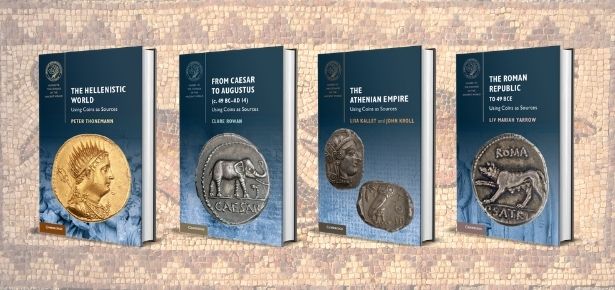
We hope you have been enjoying The Cambridge Forum webinar series! A couple of weeks ago, we had a great session exploring what coins can tell us about the Classical world, featuring Dr Gilles Bransbourg, Executive Director of the American Numismatic Society, Dr Andrew Meadows, editor of the Guides to the Coinage of the Ancient World series, and Drs Liv Yarrow and John Kroll, authors of titles in the series. You can watch the full recording of the webinar here, or read on for our highlights.
Andrew walked us through the origins of the series. In broader studies of classics, many of us have come across ancient coins as examples of what a historical figure may have looked like, or what artistic style was prevalent at the time it was minted. But coins can tell us much more than this. Some coins are inscribed and have value as texts. We can also track how much was produced and where, and how coins circulated around the ancient world. The Guides to the Coinage of the Ancient World offer accessible insights into what coins can tell us about specific periods of ancient history. Thanks to the involvement of the American Numismatic Society, each volume is also beautifully illustrated.
Liv gave us a preview of her upcoming title The Roman Republic to 49 BCE: Using Coins as Sources, and explained how she went about the process of writing the book. The book has four sections: Money, Monuments, Mutinies and Masses. Liv uses coins to explore a range of historical themes such as imperialism, the rise of powerful generals, and urban politics. In her presentation, Liv shared an example of one of her favourite coins: a 65 BCE coin created by the grandson of the Marcus Aquillius who fought in the slave revolts in Sicily in 101 BCE, which depicts M. Aquillius in military dress, holding the arm of a personification of a defeated Sicily. This is a great example of a coin being used to influence how past events are remembered– Liv explained that M. Aquillius was actually captured during the revolts! He also wasn’t fighting against Sicily, but against a slave uprising there.

Then we had a presentation from John, co-author with Dr Lisa Kallet on the recently published title The Athenian Empire: Using Coins as Sources, which aims to tell a history of the Athenian Empire with the support of numismatic evidence. John shared how his love of coins developed from an ANS lecture he attended, and the idea that numismatics offered the opportunity to combine both a historical and an archaeological approach. He explained that his book uses images of coins minted in different cities of the Athenian Empire to make these scattered cities more than just ‘dots on a map’ to the reader. The variety of coinage helps to illustrate how cities included in the Athenian Empire continued to maintain their individuality. In his presentation, John covered a range of examples of how coins can provide historians with fresh insights on topics such as the succession of different rulers and how cities used the iconography of coins to declare allegiances.
The webinar ended with a round of questions for the panel, sparking discussions on what coins can tell us about literacy in the ancient world, the importance of access to physical artefacts in inspiring future classicists, and how the series might develop in the future.
Latest Comments
Have your say!